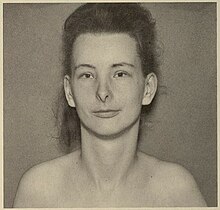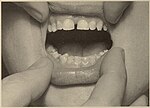| Oculodentodigital dysplasia | |
|---|---|
| Other names | Oculo-dento-digital syndrome, Oculodentodigital dysplasia , and Oculodentoosseous dysplasia |
 | |
| Woman with oculodentodigital dysplasia | |
Oculodentodigital syndrome (ODD syndrome) is an extremely rare genetic condition that typically results in small eyes, underdeveloped teeth, and syndactyly and malformation of the fourth and fifth fingers. It is considered a kind of ectodermal dysplasia.
Signs and symptoms

 Characteristics of teeth and fingers in oculodentodigital dysplasia
Characteristics of teeth and fingers in oculodentodigital dysplasia
People with ODD syndrome often have a characteristic appearance. Visible features of the condition include:
- small teeth that are prone to dental caries because of underdeveloped tooth enamel;
- a long, thin nose;
- unusually small eyes; and
- type III syndactyly of the fourth and fifth fingers.
Iris atrophy and glaucoma are more common than average. The size of the eyes often interferes with learning to read; special eyeglasses may be required. Hair may be fine, thin, dry, or fragile; in some families, it is curly.
Neurologic abnormalities may be seen in adults. The neurologic changes may appear earlier in each subsequent generation and can include abnormal white matter, conductive deafness, and various kinds of paresis, including ataxia, spastic paraplegia, difficulty controlling the eyes, and bladder and bowel disturbances.
Genetics
ODD is typically an autosomal dominant condition, but can be inherited as a recessive trait. It is generally believed to be caused by a mutation in the gene GJA1, which codes for the gap junction protein connexin 43. Slightly different mutations in this gene may explain the different way the condition manifests in different families. Most people inherit this condition from one of their parents, but new cases do arise through novel mutations. The mutation has high penetrance and variable expression, which means that nearly all people with the gene show signs of the condition, but these signs can range from very mild to very obvious.
Diagnosis
| This section is empty. You can help by adding to it. (October 2021) |
Epidemiology
The actual incidence of this disease is not known, but as of 2002, only 243 cases had been reported in the scientific literature, suggesting an incidence of on the order of one affected person in ten million people.
References
- ^ Vasconcellos JP, Melo MB, Schimiti RB, Bressanim NC, Costa FF, Costa VP (2005). "A novel mutation in the GJA1 gene in a family with oculodentodigital dysplasia". Arch. Ophthalmol. 123 (10): 1422–6. doi:10.1001/archopht.123.10.1422. PMID 16219735.
- Kelly SC, Ratajczak P, Keller M, Purcell SM, Griffin T, Richard G (2006). "A novel GJA 1 mutation in oculo-dento-digital dysplasia with curly hair and hyperkeratosis". Eur J Dermatol. 16 (3): 241–5. PMID 16709485.
- ^ Boyadjiev SA, Jabs EW, LaBuda M, et al. (1999). "Linkage analysis narrows the critical region for oculodentodigital dysplasia to chromosome 6q22-q23". Genomics. 58 (1): 34–40. doi:10.1006/geno.1999.5814. PMID 10331943.
- Gutmann DH, Zackai EH, McDonald-McGinn DM, Fischbeck KH, Kamholz J (1991). "Oculodentodigital dysplasia syndrome associated with abnormal cerebral white matter". Am. J. Med. Genet. 41 (1): 18–20. doi:10.1002/ajmg.1320410106. PMID 1659191.
- ^ Loddenkemper T, Grote K, Evers S, Oelerich M, Stögbauer F (2002). "Neurological manifestations of the oculodentodigital dysplasia syndrome". J. Neurol. 249 (5): 584–95. doi:10.1007/s004150200068. PMID 12021949. S2CID 34554090.
- Norton KK, Carey JC, Gutmann DH (1995). "Oculodentodigital dysplasia with cerebral white matter abnormalities in a two-generation family". Am. J. Med. Genet. 57 (3): 458–61. doi:10.1002/ajmg.1320570320. PMID 7677152.
- Paznekas WA, Boyadjiev SA, Shapiro RE, et al. (2003). "Connexin 43 (GJA1) mutations cause the pleiotropic phenotype of oculodentodigital dysplasia". Am. J. Hum. Genet. 72 (2): 408–18. doi:10.1086/346090. PMC 379233. PMID 12457340.
- Richardson RJ, Joss S, Tomkin S, Ahmed M, Sheridan E, Dixon MJ (2006). "A nonsense mutation in the first transmembrane domain of connexin 43 underlies autosomal recessive oculodentodigital syndrome". J. Med. Genet. 43 (7): e37. doi:10.1136/jmg.2005.037655. PMC 2564566. PMID 16816024.
- Jones KL, Smith DW, Harvey MA, Hall BD, Quan L (1975). "Older paternal age and fresh gene mutation: data on additional disorders". J. Pediatr. 86 (1): 84–8. doi:10.1016/S0022-3476(75)80709-8. PMID 1110452.
External links
| Classification | D |
|---|---|
| External resources |